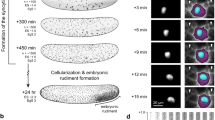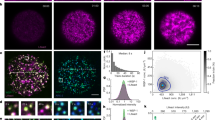Abstract
Despite the large size of the Xenopus laevis egg (approximately 1.2 mm diameter), a fertilized egg rapidly proceeds through mitosis in a spatially coordinated fashion. Mitosis is initiated by a bistable system of regulatory proteins centred on Cdk1 (refs 1, 2), raising the possibility that this spatial coordination could be achieved through trigger waves of Cdk1 activity3. Using an extract system that performs cell cycles in vitro, here we show that mitosis does spread through Xenopus cytoplasm via trigger waves, propagating at a linear speed of approximately 60 µm min−1. Perturbing the feedback loops that give rise to the bistability of Cdk1 changes the speed and dynamics of the waves. Time-lapse imaging of intact eggs argues that trigger waves of Cdk1 activation are responsible for surface contraction waves, ripples in the cell cortex that precede cytokinesis4,5. These findings indicate that Cdk1 trigger waves help ensure the spatiotemporal coordination of mitosis in large eggs. Trigger waves may be an important general mechanism for coordinating biochemical events over large distances.
This is a preview of subscription content, access via your institution
Access options
Subscribe to this journal
Receive 51 print issues and online access
$199.00 per year
only $3.90 per issue
Buy this article
- Purchase on Springer Link
- Instant access to full article PDF
Prices may be subject to local taxes which are calculated during checkout




Similar content being viewed by others
References
Pomerening, J. R., Sontag, E. D. & Ferrell, J. E., Jr Building a cell cycle oscillator: hysteresis and bistability in the activation of Cdc2. Nature Cell Biol. 5, 346–351 (2003)
Sha, W. et al. Hysteresis drives cell-cycle transitions in Xenopus laevis egg extracts. Proc. Natl Acad. Sci. USA 100, 975–980 (2003)
Novak, B. & Tyson, J. J. Modeling the cell division cycle: M-phase trigger, oscillations, and size control. J. Theor. Biol. 165, 101–134 (1993)
Hara, K. Cinematographic observation of “surface contraction waves” (SCW) during the early cleavage of axolotl eggs. Wilhelm Roux Arch. Dev. Biol. 167, 183–186 (1971)
Hara, K., Tydeman, P. & Kirschner, M. A cytoplasmic clock with the same period as the division cycle in Xenopus eggs. Proc. Natl Acad. Sci. USA 77, 462–466 (1980)
Jackman, M., Lindon, C., Nigg, E. A. & Pines, J. Active cyclin B1-Cdk1 first appears on centrosomes in prophase. Nature Cell Biol. 5, 143–148 (2003)
Newport, J. & Kirschner, M. A major developmental transition in early Xenopus embryos: I. Characterization and timing of cellular changes at the midblastula stage. Cell 30, 675–686 (1982)
Gerhart, J. C. in Biological Regulation and Development Vol. 2 (ed. Goldberger, R. F. ) 133–316 (Plenum, 1980)
Tyson, J. J. & Keener, J. P. Singular perturbation theory of traveling waves in excitable media (a review). Physica D 32, 327–361 (1988)
Markevich, N. I., Tsyganov, M. A., Hoek, J. B. & Kholodenko, B. N. Long-range signaling by phosphoprotein waves arising from bistability in protein kinase cascades. Mol. Syst. Biol. 2, 61 (2006)
Reynolds, A. R., Tischer, C., Verveer, P. J., Rocks, O. & Bastiaens, P. I. EGFR activation coupled to inhibition of tyrosine phosphatases causes lateral signal propagation. Nature Cell Biol. 5, 447–453 (2003)
Luther, R. Raumliche fortplanzung chimischer reaktionen. Z. Elektrochemie 12, 596–600 (1906)
Bonnet, J., Coopman, P. & Morris, M. C. Characterization of centrosomal localization and dynamics of Cdc25C phosphatase in mitosis. Cell Cycle 7, 1991–1998 (2008)
Murray, A. W. Cell cycle extracts. Methods Cell Biol. 36, 581–605 (1991)
Winfree, A. T. Two kinds of wave in an oscillating chemical sollution. Faraday Symp. Chem. Soc. 9, 38–46 (1974)
Wang, Y. et al. Radiosensitization of p53 mutant cells by PD0166285, a novel G(2) checkpoint abrogator. Cancer Res. 61, 8211–8217 (2001)
Nakamura, N., Tokumoto, T., Ueno, S. & Iwao, Y. The cytoskeleton-dependent localization of cdc2/cyclin B in blastomere cortex during Xenopus embryonic cell cycle. Mol. Reprod. Dev. 72, 336–345 (2005)
Rankin, S. & Kirschner, M. W. The surface contraction waves of Xenopus eggs reflect the metachronous cell-cycle state of the cytoplasm. Curr. Biol. 7, 451–454 (1997)
Shinagawa, A., Konno, S., Yoshimoto, Y. & Hiramoto, Y. Nuclear involvement in localization of the initiation site of surface contraction waves in Xenopus eggs. Dev. Growth Differ. 31, 249–255 (1989)
Perez-Mongiovi, D., Chang, P. & Houliston, E. A propagated wave of MPF activation accompanies surface contraction waves at first mitosis in Xenopus. J. Cell Sci. 111, 385–393 (1998)
Foe, V. E. & Alberts, B. M. Studies of nuclear and cytoplasmic behaviour during the five mitotic cycles that precede gastrulation in Drosophila embryogenesis. J. Cell Sci. 61, 31–70 (1983)
Haskins, E. F. Stemonitis flavogenita (Myxomycetes) – plasmodial phase (aphanoplasmodium). Film E 2000, Institut Wissenschaftliche Film, Göttingen. Pub. Wiss. Film Sekt. Biol. 8, 1–14 (1974)
Clutterbuck, A. J. Synchronous nuclear division and septation in Aspergillus nidulans. J. Gen. Microbiol. 60, 133–135 (1970)
Gladfelter, A. S., Hungerbuehler, A. K. & Philippsen, P. Asynchronous nuclear division cycles in multinucleated cells. J. Cell Biol. 172, 347–362 (2006)
Trunnell, N. B., Poon, A. C., Kim, S. Y. & Ferrell, J. E., Jr Ultrasensitivity in the regulation of Cdc25C by Cdk1. Mol. Cell 41, 263–274 (2011)
Yang, Q. & Ferrell, J. E., Jr The Cdk1-APC/C cell cycle oscillator circuit functions as a time-delayed ultrasensitive switch. Nature Cell Biol. 15, 519–525 (2013)
Hausen, P. & Riebesell, M. in The Early Development of Xenopus laevis: An Atlas of the Histology plate 12 (Springer, 1991)
Acknowledgements
We thank H. Funabiki and M. Dasso for providing GFP–NLS protein and constructs, E. Sontag and L. Wang for discussions and calculations, T. Tsai for sharing his unpublished data on the effects of PD0166285 on Xenopus embryos, Q. Yang for helping to build the ordinary differential equation model upon which our partial differential equation model is based, G. Dey, H. Stone and B. Sullivan for discussions, S. Quake and the Quake laboratory for advice, J. Chen and the Chen laboratory for the use of their microscope and discussions, J. Pomerening for discussions and technical advice, the Stanford Cell Sciences Imaging Facility for technical assistance, and members of the Ferrell laboratory for discussions. This work was supported by grants from the National Institutes of Health (GM046383 and GM077544) and by a National Science Foundation Graduate Research Fellowship and a Lieberman Fellowship (to J.B.C.).
Author information
Authors and Affiliations
Contributions
J.B.C. performed experiments and calculations, analysed data and helped write the paper. J.E.F. performed calculations, analysed data and helped write the paper.
Corresponding authors
Ethics declarations
Competing interests
The authors declare no competing financial interests.
Supplementary information
Supplementary Information
This file contains Supplementary Text and Data, Supplementary Figures 1-4 and additional references. (PDF 1030 kb)
Mitotic waves in Xenopus extracts in Teflon tubes
Nuclei appear as green circles that disappear (nuclear envelope breakdown) and reappear (nuclear envelope formation). The channel width is 100 µm. This movie corresponds to the experiment plotted in Fig. 2b. Images were obtained at a rate of 1 image per min and are shown at a rate of 15 frames per sec. (MOV 6009 kb)
Trigger waves vs. phase waves
This video is from the experiment shown in Fig. 2c. Again, the channel width is 100 µm and images were obtained at a rate of 1 image per min and are shown at a rate of 15 frames per sec. (MOV 9244 kb)
Surface contraction waves in fertilized Xenopus eggs
Two waves of pigmentation can be seen just prior to the first mitotic cleavage. Related to Fig. 4d. Images were obtained at a rate of 1 image per 10 sec and are shown at a rate of 75 frames per sec. (MOV 3740 kb)
Surface contraction waves in parthenogenetically-activated Xenopus eggs
Three pairs of waves are seen in this video. Related to Fig. 4e. Images were obtained at a rate of 1 image per 10 sec and are shown at a rate of 75 frames per sec. (MOV 3588 kb)
Rights and permissions
About this article
Cite this article
Chang, J., Ferrell Jr, J. Mitotic trigger waves and the spatial coordination of the Xenopus cell cycle. Nature 500, 603–607 (2013). https://doi.org/10.1038/nature12321
Received:
Accepted:
Published:
Issue Date:
DOI: https://doi.org/10.1038/nature12321
This article is cited by
-
Optogenetic control of YAP reveals a dynamic communication code for stem cell fate and proliferation
Nature Communications (2023)
-
An updated view on the centrosome as a cell cycle regulator
Cell Division (2022)
-
Control of protein-based pattern formation via guiding cues
Nature Reviews Physics (2022)
-
Cytoplasmic organization promotes protein diffusion in Xenopus extracts
Nature Communications (2022)
-
Optogenetic control of receptors reveals distinct roles for actin- and Cdc42-dependent negative signals in chemotactic signal processing
Nature Communications (2021)
Comments
By submitting a comment you agree to abide by our Terms and Community Guidelines. If you find something abusive or that does not comply with our terms or guidelines please flag it as inappropriate.



